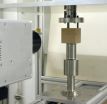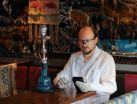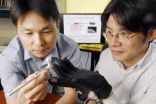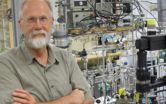Drinking just 1 measure of spirits increases the risk of acute pancreatitis
2011-08-06
Drinking just one 4cl measure of spirits can increase the risk of an acute attack of pancreatitis, but wine or beer does not appear to have the same effect, according to a study published online by BJS, the British Journal of Surgery.
Researchers from the Karolinska Institutet in Sweden followed 84,601 people from 46 to 84 years of age from the general population in Vastmanland and Uppsala for a median of ten years. During that time 513 developed acute pancreatitis.
"Our study revealed a steady increase between each measure of spirits a person drank on one occasion ...
Sexually extravagant male birds age more rapidly, but try to hide it
2011-08-06
For male houbara bustards sexual extravagance is the key to attracting mates in some of the world's harshest desert environments. However, new research in Ecology Letters reveals that males who perform the most extravagant sexual displays will suffer from premature biological aging and will pass their reproductive prime years earlier than their less ostentatious rivals.
Houbara bustards, Chlamydotis undulata, are found across the deserts of the Southern Hemisphere, from the Persian Gulf to the Gobi Desert, and for six months of the year the males spend their days in elaborate ...
Spotting weaknesses in solid wood
2011-08-06
This release is available in German.
People who buy an expensive solid wooden table or wardrobe want to be certain that their new piece of furniture is absolutely faultless. Pianos – whether upright or grand – can only produce an opulent tone if their soundboard, bridge and keyboard are made of high-quality materials. And wood that is free of imperfections is also essential in house building and window construction: load-bearing wooden beams need to be of the highest quality, as even the smallest crack can cause them to fail.
Research scientists from the Fraunhofer ...
Making runways safer
2011-08-06
This release is available in German.
It might have happened over ten years ago now, but most people can still recall the Concorde crash: the TV images showing the supersonic jet with flames streaming from its tail were unforgettable. It was a piece of metal lying on the runway during take-off that caused the accident. The aircraft's tire burst as it rolled over the metal, sending chunks of rubber flying into the fuel tank, which then exploded – with the loss of 113 lives. To avoid accidents such as this, airport staff drive up and down runways at six-hour intervals ...
Luxury Yacht Charter Croatia Magnum Nautica Announced Refreshments in Their Fleet
2011-08-06
Speaking about the makeover, Luxury yacht charter Croatia, Magnum Nautica said, "We have refreshed the interiors of all the Magnum Yachts. We have added brand new carpets, new curtains, new sofa covers and new teak on the swimming platform on the motor yacht Banana. We recently had an exclusive photoshoot by famous Croatian photographer Mario Jelavich, when our fleet went out into the Adriatic. We are planning to launch a whole new website with these photographs."
The Croatia yacht charter company Magnum Nautica owns four motor yachts in Croatia and is reputed ...
La Ninas distant effects in East Africa
2011-08-06
5 August 2011 | Potsdam: For 20 000 years, climate variability in East Africa has been following a pattern that is evidently a remote effect of the ENSO phenomenon (El Niño Southern Oscillation) known as El Niño/La Niña. During the cold phase of La Niña, there is marginal rainfall and stronger winds in East Africa, while the El Niño warm phase leads to weak wind conditions with frequent rain. Moreover, during the coldest period of the last ice age about 18 000 to 21 000 years ago, East Africa's climate was relatively stable and dry. This result was published by an international ...
Disappearance of genetic material allows tumor cells to grow
2011-08-06
Malignant Sézary syndrome is characterized by the reproduction of a special type of white blood cells in the skin of male and female patients. In contrast to most other skin lymphomas, patients with Sézary syndrome manifest not only skin contamination but also contamination of blood and lymph nodes by degenerate T cells even at the onset of the disease. The researchers investigated highly purified tumor cells from patients with Sézary syndrome using modern, high-resolution genetic procedures (the so-called array comparative genomic hybridization technique) for hitherto ...
Have we met before? Scientists show why the brain has the answer
2011-08-06
The research, led by Dr Clea Warburton and Dr Gareth Barker in the University's School of Physiology and Pharmacology and published in the Journal of Neuroscience, has investigated why we can recognise faces much better if we have extra clues as to where or indeed when we encountered them in the first place.
The study found that when we need to remember that a particular object, for example a face, occurred in a particular place, or at a particular time, multiple brain regions have to work together - not independently.
It has been known for some time that three brain ...
Polymer's hunt for nicotine
2011-08-06
Newly synthesized polymer, fitted with molecular pincers of carefully tailored structure, effectively captures nicotine molecules and its analogues. The polymer can be used for fabrication of sensitive and selective chemical sensors to determine nicotine in solutions, and in the near future also in gases. Moreover, the polymer is suitable for slow, controlled release of nicotine, e.g., for therapeutic purposes.
The collaboration of researchers of the Institute of Physical Chemistry of the Polish Academy of Sciences (IPC PAS) and of the Department of Chemistry, Wichita ...
Fossils of forest rodents found in highland desert
2011-08-06
Two new rodent fossils were discovered in the arid highlands of southern Bolivia by researchers from Case Western Reserve University School of Medicine and Universidad Autónoma Tomás Frías.
The larger of the two rodents, named Mesoprocta hypsodus, probably looked something like a guinea pig on stilts, said Darin Croft, an anatomy professor at Case Western Reserve. The smaller, Quebradahondomys potosiensis, was a spiny rat.
An online article in the Journal of Mammalian Evolution describes the new species, a possible third, and two known species that are new inhabitants ...
Black and White Custom Effect Transforms Family Photographs into Cherished Canvas Prints
2011-08-06
Photo in Canvas provide a premium service to customers looking to transform photographs into exceptional canvas prints. The Hampshire based studio specialise in producing custom effects and one of the latest, contrasting black and white, can completely revamp a tired looking photo.
The designer custom effects range at Photo in Canvas is extensive giving customers plenty of choice when it comes creating their canvas prints. The custom effects are usually free of charge and customers can preview their creations before buying them to ensure everything is at it should be.
One ...
Researchers develop fully cooked food-aid product
2011-08-06
This release is available in Spanish.
U.S. Department of Agriculture (USDA) scientists have developed a fully cooked food-aid product called Instant Corn Soy Blend that supplements meals, particularly for young children.
The work was led by food technologist Charles Onwulata at the Agricultural Research Service (ARS) Dairy Processing and Products Research Unit at the agency's Eastern Regional Research Center (ERRC) in Wyndmoor, Pa.
ARS is USDA's chief intramural scientific research agency, and this research supports the USDA priority of promoting international food ...
Wearable device that vibrates fingertip could improve one's sense of touch
2011-08-06
A little vibration can be a good thing for people who need a sensitive touch.
Researchers at the Georgia Institute of Technology have developed a glove with a special fingertip designed to improve the wearer's sense of touch. Applying a small vibration to the side of the fingertip improves tactile sensitivity and motor performance, according to their research results.
Previous research has shown that adding an appropriate amount of white noise -- a concept called stochastic resonance -- can improve sight, hearing, balance control and touch, but the white noise had not ...
AsiaRooms.com - Asia Fitness Convention to be Held in Bangkok
2011-08-06
Anyone keen to learn about the best ways of staying in shape may enjoy the Asia Fitness Convention (AFC) 2011, which will be held in Bangkok soon.
While the official conference programme runs from October 21st to 23rd, there will be additional sessions taking place before and after those dates in specialist areas such as sports conditioning, ultimate six plus trigger point therapy and freeform body workshop.
The organisers have urged people to register for their tickets as soon as possible, so that they can be sure they do not miss out on the workshops they want ...
Cells die so defensive organs can live
2011-08-06
Researchers demonstrate for the first time that programmed cell death - a process by which cells deliberately destroy themselves - is involved in mandibular regression in termites. And it appears this regression may be the price to pay for the formation of termites' defensive organs, according to Kouhei Toga and Kiyoto Maekawa from the University of Toyama, and Shinichi Yoda from the University of Tokyo, in Japan. Their findings have just been published online in Springer's journal Naturwissenschaften – The Science of Nature.
As termites molt from workers, to presoldiers ...
AsiaRooms.com - Phuket to Host Still Smokin Music and Movie Event
2011-08-06
Jim Newport will be hosting an exhibition of his film and television-related work in Phuket this month, as well as taking the stage with his blues band.
While many people on the island may recognise him from a handful of appearances as the lead singer of Jimmy Fame at the Phuket International Blues Festival, Newport is also an acclaimed production designer.
Among the work that has won him Emmy nominations is baffling sci-fi series Lost, which revolved around a group of people from across the world stranded on an exotic island.
In addition to this, Newport has ...
High-risk stroke patients more likely to get follow-up care after motivational talk
2011-08-06
ANN ARBOR, Mich. — Even though many Americans learn through community health screenings that they are at high risk for having a stroke, they rarely follow-up with their doctor for care.
But a new University of Michigan study shows high-risk stroke patients are twice as likely to get follow-up care from a primary care doctor if they receive a pep talk over the telephone.
"It is unfortunate that these high-risk patients often have a lower rate of follow-up with their primary care physicians," says Rajesh Balkrishnan, Ph.D., associate professor in the College of Pharmacy ...
The last 3 million years at a snail's pace
2011-08-06
Scientists at the University of York, using an 'amino acid time capsule', have led the largest ever programme to date the British Quaternary period, stretching back nearly three million years.
It is the first widespread application of refinements of the 40-year-old technique of amino acid geochronology. The refined method, developed at York's BioArCh laboratories, measures the breakdown of a closed system of protein in fossil snail shells, and provides a method of dating archaeological and geological sites.
Britain has an unparalleled studied record of fossil-rich ...
AsiaRooms.com - Kuala Lumpur Design Week Coming Up in September
2011-08-06
Emerging talents in the creative sphere will come together for Kuala Lumpur Design Week from September 16th to 25th 2011.
With the tagline 'Reaching for the Stars', the event aims to find people with the passion and skill to help Malaysia make an impression on the global stage in terms of design.
The organisers explained that experts from around the globe will share their abilities with eager beginners, with several awards due to be handed out to talents who excel.
In a statement, they added: "The festival is to instil, stimulate and magnify our country's ...
One box of Girl Scout Cookies worth $15 billion
2011-08-06
Scientists can make graphene out of just about anything with carbon -- even Girl Scout Cookies.
Graduate students in the Rice University lab of chemist James Tour proved it when they invited a troop of Houston Girl Scouts to their lab to show them how it's done.
The work is part of a paper published online today by ACS Nano. Rice scientists described how graphene -- a single-atom-thick sheet of the same material in pencil lead -- can be made from just about any carbon source, including food, insects and waste.
The cookie gambit started on a dare when Tour mentioned ...
Locally owned small businesses pack powerful economic punch
2011-08-06
Thinking small and local, not big and global, may help communities ignite long-term economic growth, according to Penn State economists.
Small, locally owned businesses and startups tend to generate higher incomes for people in a community than big, nonlocal firms, which can actually depress local economies, said Stephan Goetz, professor of agricultural and regional economics.
"Local ownership matters in important ways," said Goetz. "Smaller, locally owned businesses, it turns out, provide higher, long-term economic growth."
The association of small businesses ...
Ereviewguide.com Helps Illustration Artists Save Money
2011-08-06
Illustrator software packages have really broadened the creative power of the illustrators. Gone are the days of endless drawings, erasing, scaling and tracing. All of these can be done with a click of a button with powerful illustrator software. This type of software really turbo charges the creative process so that illustrations that used to take days can be finished in hours if not within an hour. These pieces of software automate the most tedious and manual part of the illustration process and makes an artist's creative flow more dynamic and smooth. However, there are ...
6 million years of African savanna
2011-08-06
Scientists using chemical isotopes in ancient soil to measure prehistoric tree cover--in effect, shade--have found that grassy, tree-dotted savannas prevailed at most East African sites where human ancestors and their ape relatives evolved during the past six million years.
"We've been able to quantify how much shade was available in the geological past," says University of Utah geochemist Thure Cerling, lead author of a paper titled "Woody cover and hominin environments in the past 6 million years" on the results in this week's issue of the journal Nature.
"It shows ...
Launch of New Site Advance America Cash Offering Payday Loans Online
2011-08-06
The concept of the no fax payday loans has eased the financial troubles of hundreds of people across the globe. This is the reason these types of loans are fast becoming popular within the different countries of the world. The individuals can borrow an amount of money according to their needs to facilitate their cash flows before their next salary day. This way they can meet their urgent needs like paying for car maintenance, doctor's fees and other related issues. There are a number of banks and the financial institutes like Sky Loans offering these types of loans for ...
Potato trials and research provide grower information
2011-08-06
SPRINGLAKE – Whether it is a purple potato to fit a niche market or finding varieties resistant or at least tolerant to psyllid infestations, Dr. Creighton Miller has a potato plant in Texas aimed at meeting a grower's need.
Miller, a potato breeder with Texas AgriLife Research and the Texas A&M University department of horticultural sciences in College Station, has breeding trials near Springlake and Dalhart.
Selections are made from seedlings grown in breeding plots each year, he said. The children of these "families," as the parent plants are known in potato breeding, ...
[1] ... [6922]
[6923]
[6924]
[6925]
[6926]
[6927]
[6928]
[6929]
6930
[6931]
[6932]
[6933]
[6934]
[6935]
[6936]
[6937]
[6938]
... [8705]
Press-News.org - Free Press Release Distribution service.








